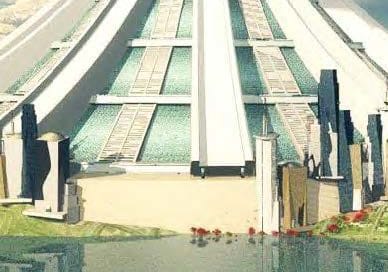This story features in Unearthed: Geoscience for good
Looking like the cover of a sci-fi novel, the X-Seed 4000 is a futuristic concept building designed to tower 4,000m over the Tokyo skyline. The visionary skyscraper (or “skypenetrator”) was conceived in the mid-1990’s by Taisei Corporation. Capable of accommodating up to one million inhabitants, it combines ultra-modern living with emerging transport methods and interaction with “nature”. It’s a structure that epitomises the futuristic vision of the engineering community and the evolution of humankind.
Why it fascinates me
When I was young, I spent countless hours scouring encyclopedias, books and magazines for content of interest and I would often find myself gravitating towards articles of a more technical or futuristic nature. In many of these books, we had permanently occupied bases on Earth’s Moon or Mars; we all travelled around in flying cars; and we communicated with each other via wrist worn devices. In 2020, the reality is that we are far from achieving some of these lofty aspirations, but technological advancements over the last few decades alone have realised some technology previously in the domain of science fiction.
As the global population continues to grow, an ever-increasing percentage of people are living in urban centers, shifting our historically dispersed geographical existence into highly concentrated areas. The demand for space in these locations is necessitating the construction of larger buildings to house, entertain and provide for significantly more people than these city areas were originally designed for.
In my lifetime, there have been 14 buildings completed that are taller than the tallest building when I was born, with a further 16 currently under construction. The tallest of those is the Jeddah Tower (formerly the Kingdom Tower), which will stand over 1km tall if it is completed, and begs the question; how big can and will we build?
How it works
X-Seed 4,000 is essentially a self-contained city in a building. A 4km (2.5mi) high, eco-utopian environment comprising over 800 floors in the open framework of a concave cone shape, aesthetically resembling Mt Fuji. With residential, commercial and urban space spread throughout the building, residents need never leave. Since the structure is so tall, special consideration is needed to manage the variations in air pressure throughout the building to avoid altitude sickness.
Renewable energy generators would be spread throughout the structure to provide the bulk of the power requirements while reducing the overall weight of power cables. The base is 6km (3.7mi) in diameter to support the massive weight with the concave cone providing stability to the structure at height. The open structure of the tower enables some air to flow through the perimeter of the building and lightens the load on the foundations and lower levels while also providing a path for natural light.
What it offers
Despite X-Seed 4000 holding the title for being the largest building to ever be “fully designed”, it is unlikely to ever be built. What it does provide, however, is the impetus to drive not only innovations, but also inventions as we conceive the material, environmental, social and design requirements of a structure so massive.
Advancements in design technology, modelling and simulation have enabled the rapid evolution of engineering structures and the materials used to create them by combining advanced numerical simulations to rapidly generate and assess design models without the historic need for extensive prototyping. The higher levels of confidence that are gained through these processes also reduce risk and subsequent overengineering, enabling engineers to push boundaries with a greater degree of confidence.
As the world evolves and we look for new ways to inhabit the planet, we are starting to realise that everything that we put in, take out, or change to the Earth has potentially far-reaching effects, and no infrastructure decision should be taken without appropriate and thorough consideration.
Geology’s role in future infrastructure
Often hidden from view, it is easy to overlook the significance that geology plays in all infrastructure projects. The subsurface can be directly impacted through mechanical means such as supporting foundations, excavations or tunnels, or further afield by alteration to the water table or contamination of groundwater. Geology is a complex topic as there are many variables that need to be managed in parallel in order to gain a more complete picture of the subsurface conditions. Understanding these variables and being able to put them into context is the first step in addressing the risks of any project and formulating appropriate measures to minimise the impact it will have.
I think Leapfrog Works provides an ideal platform to collate these geological variables in order to put them into context, to visualise and communicate their significance, and to provide the necessary inputs for numerical analysis. As we continue to build bigger, taller and more massive buildings, our potential impact on the environment also grows. Through the diligence of the geoscience community, armed with the knowledge and tools to make a difference, we can ensure that these mega-structures of the future… tread lightly.

Adam North
Regional Business Development Manager, Seequent
